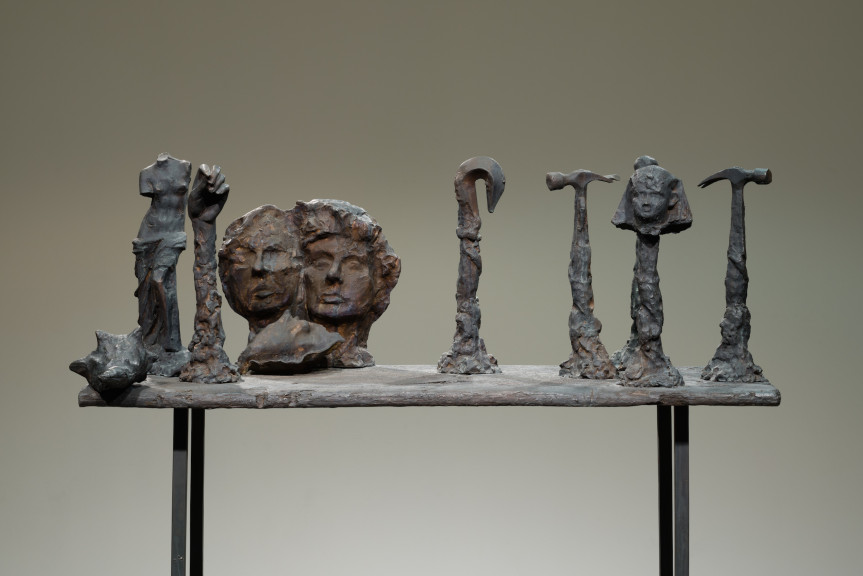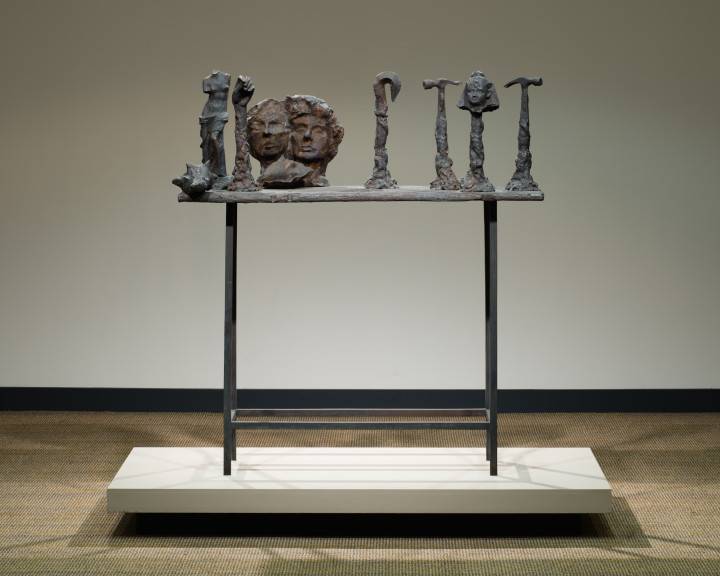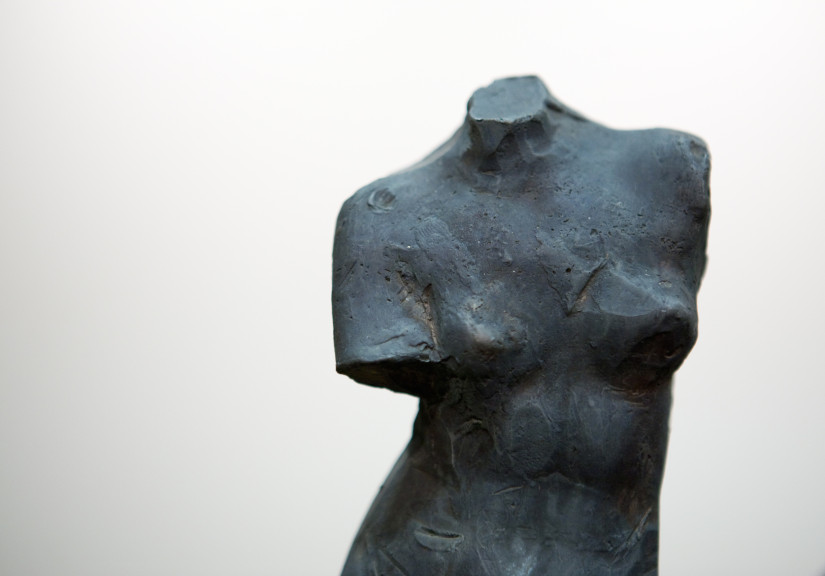History of Black Bronze I
Jim Dine
53-1/4 × 48 × 20 inches
Photography not permitted
Lent by The Metropolitan Museum of Art Gift of Industrial Petro-Chemicals, Inc., 1987
1987.363
GPS: 30.285849,-97.731508
Born and raised in Ohio, Jim Dine moved to New York in 1958 and established himself in the art world with theatrical Happenings performed in chaotic, artist-built environments. In the early 1960s, Dine was among a growing number of young artists working with commercial imagery and everyday objects. In contrast to the dominant trend toward abstraction, Dine and other Pop artists sought to bridge the gap between fine art and life. Pop artists chose ordinary objects as their subjects, presenting them with detachment and irony. For example, Dine painted images of bathrobes, neckties, hearts, and tools, sometimes incorporating actual objects into his compositions—a decision that marked the beginning of his interest in sculpture.
By the late 1960s, Dine turned his attention from ordinary objects to those that had personal significance. His composition of objects on a table may pay homage to Alberto Giacometti (1901–1966), whose Surrealist Table (1933) features objects that refer to the artist’s other sculptures. In History of Black Bronze I, Dine updated that idea to the 1980s taste for art historical appropriation by reproducing truncated versions of famous monuments from antiquity, like the Greek sculpture Venus de Milo and the face of the Great Sphinx of Giza. These are placed alongside casts of household tools that became symbolic subjects for the artist, a resonance that stems from Dine’s time working in his family’s hardware store.
The near uniform size and surface quality of the objects on the table elevate the mundane hammer to the level of appreciation warranted by the classical Venus de Milo. Dine has described his approach in works like History of Black Bronze I as “metaphorical realism,” a type of meaning that is not rooted in words but in objects. Seen through this lens, the array of items can be understood as a portrait of the artist, his influences, and his techniques.
ACTIVITY GUIDES

History of Black Bronze I
Jim Dine
Subject: Appropriating objects
Activity: Creating a collage of your life
Materials: Magazines, small objects, glue, paper
Vocabulary: appropriation, bronze, depict
Jim Dine grew up in Cincinnati, Ohio, where his family owned a hardware store. Dine often depicts tools in his art. In this piece, Dine shows tools alongside several reproductions of famous works of art. When artists use existing objects in their work (as opposed to creating them originally), they are using a method called appropriation.
Do you see familiar objects?
Which objects did the artist make? Which were appropriated?
Why do you think the artist placed his tools alongside the other objects?
Create a collage that tells a story about your life. Use pictures from magazines or small objects and glue them to a new sheet of paper. Add your own drawings to the paper. Which parts are original, and which are appropriated?
Appropriation - using something not made by you
Bronze - a gold-brown metal that is a mixture of copper and tin
Depict - to represent by a picture
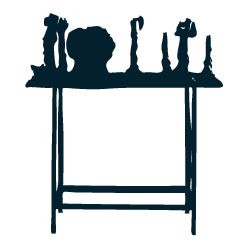
History of Black Bronze I
Jim Dine
Subject: Pop Art
Activity: Reproduce a familiar tool
Materials: Pencil, pen, paints, and paper
Vocabulary: Pop art, appropriation, symbolism
Jim Dine is a painter and sculptor working in a Pop Art style. Growing up, his family owned a hardware store, and so he often depicts tools in his works of art. Notice in this sculpture how Dine used symbolism. He placed symbols of tools, such as a hammer, alongside symbols of familiar works of art, like the Venus de Milo. The artist may be suggesting that the everyday tools of an artist can also be seen as historically valuable and visually pleasing. This approach is common in Pop art, which aims to make art more familiar and approachable by using everyday objects as symbols for greater meanings.
What kind of objects do you see? What do these objects symbolize to you?
Are some of these items familiar to you? Have you ever thought that everyday objects could be seen as art?
How can we tell the difference between familiar objects of our daily lives and that of art?
Is the artist challenging our idea of art? How might we begin to see the beauty of everyday objects and the purpose of art?
Choose a tool that is used frequently in your home, such as a toothbrush, scissors, or something from the kitchen like a spatula. Make several drawings of it in different sizes using a variety of media, such as pen and pencil or paint. Compare your artworks to each other and to the original subject you chose. How does the change in size and media affect how you view the object? Does the object seem different to you now that you have taken it out of its original context? What new things do you notice about the object?
Pop Art -- a visual art movement that emerged in the 1950’s which is characterized by the use of imagery and techniques drawn from mass media and popular culture
Appropriation -- using something not made by you
Symbolism -- representing an idea or concept through images
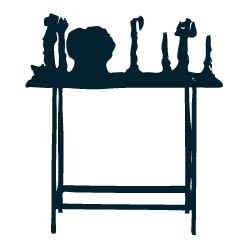
History of Black Bronze I
Jim Dine
Subject: Everyday objects as art
Activity: Make a work of art about an object you use everyday
Materials: Modeling clay or paper and pencil
Vocabulary: Depict, sculptor, sculpture
Jim Dine is a painter and sculptor who grew up in Cincinnati, Ohio, where his family owned a hardware store. He often makes works of art that depict everyday objects, including tools. In this sculpture, he places everyday objects beside symbols of great works of art. In doing so, the artist may be telling us that he considers ordinary objects to be works of art too.
What ordinary objects do you see in this sculpture?
What other objects do you see? Do they depict something in history?
How might this array of objects tell a story?
Have your child choose a media of their preference (modeling clay, pen or pencil on paper, collage) and to try to replicate an object your child uses everyday (such as a toothbrush, a fork, or a pencil). Then, create objects from history (like a pyramid) and arrange them in a row. Tell a story about these objects and how they relate to one another. You can also make some of these objects much bigger or smaller than their real size. Ask how the change in size affects the way your child sees them. Point out the new things you notice about these objects.
Depict —To represent by a picture
Sculptor —An artist who makes works of art that have height, width, and depth
Sculpture —A work of art that has height, width, and depth
MORE INFORMATION
After leaving Cincinnati for New York in 1958, Jim Dine became one of the pioneers of pop art. Pop artists often chose ordinary everyday objects as their subjects, presenting them with detachment and irony. In part, this was a natural reaction of young artists against the previous generation’s elevated aspirations for abstract expressionism in the 1940s and 1950s. Pop artists consciously developed the cynicism of Dada artists of the 1910s and 1920s (Marcel Duchamp, for example, made “art” from bicycle parts, a snow shovel, even a urinal) to express their rejection of bourgeois society and the concurrent enthusiasm for abstraction.
To that background the Pop artists added an acceptance of the emblems of our consumer society and “low-brow” popular culture. Roy Lichtenstein appropriated images from comics; Andy Warhol painted images of Campbell’s soup cans and Brillo boxes; Jasper Johns favored flags and maps; and Robert Rauschenberg used almost anything from old tires and broken furniture to stuffed birds and electric lights.
Dine painted many images of bathrobes, neckties, hearts, and tools; some compositions incorporated actual objects. Five Feet of Colorful Tools and Black Garden Tools (both 1962) each consisted of a nearly blank canvas surmounted by a row of painted hand tools (one in bright hues, the other in ominous black). This incorporation of real objects marked the beginning of Dine’s interest in sculpture, though he did not develop this tendency until a decade later when he settled his family on a farm in Vermont. The painting Our Life Here (1972) consisted of a row of utilitarian objects, including a penknife, gardening gloves, and a shaving brush. The ordinary objects from his brash pop art days had become personal, referring not only to his own lifestyle but to his family heritage: as a child he had grown up among the wares in his parents’ hardware store.
History of Black Bronze I, 1983
History of Black Bronze I is best understood in the context of art in the 1980s, when many artists referred to and borrowed from historic sources in a process they called “appropriation.” Art became the subject of art.
In format, Dine’s composition of objects on a table may refer to Alberto Giacometti’s surrealist Table (1933), which featured a partially veiled head, a horizontal hand, and a polyhedron on a table. Giacometti’s array of objects referred to other sculptures he was working on at the time. Dine’s History of Black Bronze updated that idea to the 1980s taste for art historical appropriation. He chose objects ranging from icons of classical art to ordinary tools. On the left stands a reproduction of the Venus de Milo, one of the most admired sculptures of a goddess from ancient Greece and one of the major attractions in the Louvre Museum in Paris. Next to the statuette, an upward-reaching hand refers to the expressively modeled hands sculpted by Auguste Rodin in the late nineteenth century. The inspiration for the two adjoining heads is more difficult to pin down; perhaps an allusion to the expressionist heads sculpted by Giacometti in the last decades of his life. On the right, Dine appropriated the head of an Egyptian pharaoh, possibly that of Tutankhamen (a blockbuster exhibition devoted to Tut and his treasures had toured the U.S. in the late 1970s). Dine flanked that image with two hammers, as if to break up the aura of hype and commercialization surrounding King Tut. The tools also refer to Dine’s own paintings of such mundane objects.
Dine’s choice of title and material make further reference to history: the radical transformation of human society and art from the Stone Age to the Bronze Age. As an alloy consisting primarily of copper, bronze starts out as reddish gold and weathers to a bluish green or brown. To become black, bronze requires human intervention; for millennia, bronze casters had applied chemicals to create a black patina over the surface of bronze statues. The word “black” in the title may also allude to the darker history of bronze in ancient times: the alloy facilitated the making of weapons.
Valerie Fletcher is Senior Curator at the Hirshhorn Museum in Washington, DC. Her research on groundbreaking aspects of international, globalized, and transnational art have resulted in numerous exhibitions and publications.
Beal, Graham W. J. Jim Dine: Five Themes. Minneapolis: Walker Art Center, 1984. Texts by Robert Creeley, Jim Dine, and Martin Friedman.
Celant, Germano, and Clare Bell, eds. Jim Dine: Walking Memory, 1959–1969. New York: Guggenheim Museum, 1999. Texts by Clare Bell, Julia Blaut, Germano Celant, and Jim Dine.
Dine, Jim. “A Statement.” In Michael Kirby, ed., Happenings: An Illustrated Anthology. New York: Dutton, 1965.
Feinberg, Jean E. Jim Dine. New York: Abbeville Press, 1995.
Gruen, John. “Jim Dine and the Life of Objects.” Art News 76 (September 1977): 38–42.
Livingstone, Marco . Jim Dine: The Alchemy of Images. New York: Monacelli Press, 1998.
Shapiro, David. Jim Dine: Painting What One Is. New York: Abrams, 1981.
Swenson, Gene. “What is Pop Art? Answers from Eight Painters, Part I: Jim Dine.” Art News 62 (November 1963): 25, 61–62.
The Metropolitan Museum of Art in New York generously loaned twenty-eight modern and contemporary sculptures to Landmarks for display throughout the Austin campus. The collection represents a broad array of artists working in the second half of the twentieth century. The initial sculptures were installed throughout the main campus in September 2008, and a second, smaller group were unveiled at the renovated Bass Concert Hall in January 2009.
Funding for the loan was provided by the Office of the President. This project was the result of a collaborative effort among many, including:
Leadership
Andrée Bober and Landmarks
Pat Clubb and University Operations
Douglas Dempster and the College of Fine Arts
Landmarks Advisory Committee
William Powers and the Office of the President
David Rea and the Office of Campus Planning
Bill Throop and Project Management and Construction Services
Gary Tinterow and the Metropolitan Museum of Art
Samuel Wilson and the Faculty Building Advisory Committee
Project Team
Chuck Agro, transportation, Metropolitan Museum of Art
Andrée Bober, curator and director, Landmarks
Caitlin Corrigan, registrar, Metropolitan Museum of Art
Cynthia Iavarone, collections manager, Metropolitan Museum of Art
Cliff Koeninger, architect
Ricardo Puemape, Project Management and Construction Services
Kendra Roth, conservator, Metropolitan Museum of Art
Patrick Sheehy, installation services
Nicole Vlado, project manager, Landmarks
Special Thanks
Valerie Fletcher, curatorial contributor
Beth Palazzolo, administrative coordination, University Operations
Russell Pinkston, composer
What’s Past Is Prologue: Inaugurating Landmarks with the Metropolitan Sculptures
With the arrival of twenty-eight modern sculptures on long-term loan from New York’s Metropolitan Museum of Art, the Landmarks program has begun. Their installation throughout the Austin campus offers a remarkable opportunity to survey some of the major trends in art during the second half of the twentieth century. These sculptures allow us to witness the distinctly modern dialogue between representation and abstraction, as well as the contest between natural and industrial materials. Most of all, we can celebrate their presence as an unprecedented chance to experience works of art first-hand––to appreciate their forms and to understand the underlying ideas.
The Landmarks program perpetuates in Austin one of civilization’s oldest and most enduring traditions: the placing of art in public areas, accessible to nearly everyone and expressive of collectively held ideas. More than five thousand years ago, the cultures of Egypt and Mesopotamia produced sculptures for urban plazas, government buildings, and places of worship to express political, secular, and religious values. Grand monuments endorsed the ruling elite and commemorated military victories, while images of deities symbolized spiritual beliefs. The original purposes of public art were primarily ideological and didactic, but what has endured through the ages is the physical beauty of the art. In modern times the contexts and goals for public art have changed considerably. In many parts of the world democracy and egalitarianism have supplanted absolute rulers, and explicit religious power has yielded to secular humanism. During the mid-to-late twentieth century (the era when the Metropolitan’s sculptures were created), globalization has redefined the entire world. Societies in Europe and the Americas have became so diverse that cultural authorities can no longer be sure of which systems of meaning and which values, let alone which individuals, should be honored in the traditional ways of public art.
A schism has developed between traditionalists and modernists. In a rapidly changing world those who wanted to preserve the familiar in art have continued to commission representational statues. Modernists, on the other hand, have embraced change and gladly jettisoned the old ways in favor of abstraction. The schism is exemplified by two famous memorials in Washington, D.C., both intended to commemorate the heroic sacrifices of American armed forces. The Marine Corps Memorial (1954) consists of a superbly realistic representation of soldiers struggling to raise the American flag on Iwo Jima in 1945. In contrast, the Vietnam Memorial (1982) consists of a massive V-shaped wedge of polished black stone inscribed with What’s Past Is Prologue: Inaugurating Landmarks with the Metropolitan Sculptures July 2008 the names of the dead. At the time it was inaugurated, this monument shocked nearly everyone outside the art world and outraged many of those it intended to commemorate. In response, a group of bronze figures of soldiers was added. But soon, precisely because of its universal form and absence of imagery, the original memorial became a powerful place where all Americans could go to grieve, remember, and pay homage. To most of the art world, this demonstrated beyond a doubt the viability of abstract sculpture for public places.
With America’s increasing wealth and social consciousness in the 1960s many towns began to institute programs of commissioning sculptures for public places. By requiring that 1 or 2 percent of each building’s construction budget be used for art, urban planners sought to improve the living and working environment for millions of people. The main difficulty was agreeing on what kind of art was visually pleasing and, just as important, potentially meaningful to the general public. Two highly publicized examples were the huge, abstract, metal sculptures by Pablo Picasso and Alexander Calder, in Chicago and Grand Rapids respectively, which at first provoked derision but gradually became a source of community identity and pride.
One way to approach works of art is to consider the historical context in which they were created. During the first half of the twentieth century, life and art underwent radical transformations. Industrial manufacturing supplanted agriculture as the dominant mode of production, people migrated from rural areas to urban centers, women and minorities gained equal rights, warfare expanded to an unprecedented global scale, and technology accelerated the pace of life—and art changed in tandem.
Abstraction
Early in the modern era, many artists believed that a new visual language was needed to replace the Greco-Roman classical figurative traditions that had persisted through two millennia. Photography had made mimesis (accurate depiction of reality) unnecessary in painting and sculpture for the first time in history. Artists were free to conceive radically new approaches, and so abstraction was born, emerging from 1910 to 1920 in Europe. Initially artists simplified and stylized observed reality into organic and angular forms. That first phase soon evolved into making “pure” abstractions with no recognizable sources. From the outset, abstract art carried implicit meanings recognized by artists and informed viewers but largely lost on the general public.
Early abstractionists intended their art to convey their commitment to an ongoing transformation of society. Like Morse code in telegraphy and other new modes of communication fundamentally different from the traditional written word, abstract forms in art could convey meanings—not narrative or literal ones but broad ideas that could speak to an international audience and help advance human consciousness.
During the 1920s and 1930s, artists developed two broad types of abstraction: geometric and biomorphic. Geometry denotes mathematics and suggests such related disciplines as architecture, design, engineering, and logic as well as intangible qualities like analytical thinking and precision—desirable attributes for a rational, communal society. Artists devised a new language of geometry in art: horizontal and vertical elements can convey calm, harmony, and stability (see Harmonious Triad by Beverly Pepper), while rising diagonals can suggest energy and optimism (see Column of Peace by Antoine Pevsner and Square Tilt by Joel Perlman).
In contrast to geometric abstraction, a number of artists favored softer forms and curving contours. Inspired by sources in nature, biomorphic abstractions evoke natural phenomena, biological processes, growth, and ambiguity (see Big Indian Mountain by Raoul Hague, Source by Hans Hokanson, and Untitled [Seven Mountains] by Ursula von Rydingsvard). Such works stand in general opposition to the industrial and technological aspects of modern life; they remind us of the fundamental importance of the natural world. Biomorphism was invented and advocated by the surrealists, who believed in the importance of the unconscious mind in creating and understanding modern art. Relying on the Freudian concept of free association, such artists expect viewers to generate their own unique responses to abstract art.
The two types of abstraction began as competing and opposing philosophies, but by the 1950s many artists expertly combined them to suit their expressive needs (see the rhythmic contours of Veduggio Glimpse by Anthony Caro and the disconcerting, hulking forms of Catacombs and Guardian by Seymour Lipton).
By the 1960s, the original philosophical meanings underlying abstraction had mostly faded away, leaving “formalist” aesthetics: the creation and appreciation of pure nonreferential beauty. Formalism dominated much artistic practice from the 1950s through the 1970s, particularly in the United States in the circle around the critic Clement Greenberg. Geometric sculptures became ubiquitous in public places—some complex and sophisticated and some merely competent. A group known as the minimalists advocated an intellectually rigorous, austerely reductivist approach (see Amaryllis by Tony Smith). Other artists went in the opposite direction, toward complexity and a decorative verve (see Kingfish by Peter Reginato). From those extremes emerged the postminimalists, who infused organic vitality into simple, singular forms (see Curve and Shadow No. 2 by Juan Hamilton).
Figuration
Despite the enthusiasm for abstraction in midcentury, a number of artists insisted on maintaining recognizable human content in their works. Abstraction had alienated many viewers who found it remote or incomprehensible. Yet few artists returned to traditional realism, preferring instead to explore new and evocative modes of representation.
The strongest resurgence occurred in the aftermath of World War II. Many artists, especially in Europe, wanted to pay homage to the sufferings experienced by so many people during the war and to their struggles to rebuild their lives and societies amidst the new fears engendered by the nuclear age and the Cold War. This atmosphere of postwar existential anxiety was poignantly expressed in two museum exhibitions in the 1950s: models for a never-realized Monument to the Unknown Political Prisoner at London’s Tate Gallery in 1953 and the avowedly humanist theme of the New Images of Man installation at New York’s Museum of Modern Art in 1959.
Many postwar sculptors expressed their angst by portraying figures or fragments of bodies as falling, broken, injured, or partially robotic (see Augustus by Bernard Meadows and Figure by Eduardo Paolozzi). Some erudite artists reinterpreted classical myths, particularly those in which a hero challenged the gods and were punished: Icarus, Hephaestus, Prometheus, Sisyphus (see works by Koren der Harootian and Frederick Kiesler). Seymour Lipton created a particularly effective amalgam of figure references within abstract forms that harbor dark inner spaces (see Pioneer, Catacombs, and Guardian).
Representational sculpture was submerged by the tidal wave of abstraction in the 1960s and 1970s, but a new generation insisted on a legible humanist content in art, addressing issues of personal identity and isolation in an impersonal world (see Eyes by Louise Bourgeois and Figure on a Trunk by Magdalena Abakanowicz).
Materials and Methods
Modern sculptors also introduced a new language of materials and methods. In the late nineteenth century, sculpture making had entered a new phase of mass production made possible through technology: bronzes could be produced in large editions by skilled technicians from an artist’s original. The Thinker by Auguste Rodin, for example, was made in several editions, ranging from a dozen life-size bronzes to hundreds of smaller casts. This mechanization and concomitant commodification of art prompted a reaction. Appearing simultaneously in several countries, the “direct carve” movement advocated older craft-based methods and sought to enhance the intrinsic characteristics of natural materials: the color and grain of exotic woods or the veining and crystalline structure of unusual stones. By the 1920s, this aesthetic had gained international prominence, and it persists to this day.
The first generation of direct carvers admired prehistoric, African, Oceanic, and indigenous American artifacts. By adapting the hieratic frontality and stylized forms of those sources to the sleekly refined forms of abstraction, modern sculptors could represent simplified figures linked in sophisticated linear rhythms (see works by Koren der Harootian and Anita Weschler). Recent artists of this orientation tend to work on a larger scale and may roughly cut and hew wood to achieve expressionistic textures (see works by Hans Hokanson and Ursula von Rydingsvard).
Carvers remained a relatively small minority in modern sculpture, far outnumbered by “direct metal” sculptors. Their approach emerged in prewar Europe and burgeoned into an international movement in the 1950s and 1960s. Seeking materials and methods appropriate to the modern Machine Age, artists looked to engineering and construction for inspiration. Instead of using chisels to carve wood and stone, constructivists preferred welding torches to cut and join pieces of metal. Their structures ranged from elegant abstractions to assemblages of cast-off objects.
The industrial analogy and model extended to the sculptors’ own studios, which resembled factory spaces with heavy-duty equipment. Some—like Anthony Caro, Willard Boepple, and Robert Murray—found inspiration in working spontaneously and experimentally with sheet metal: cutting, folding, rolling, welding, soldering, and sometimes painting or burnishing it. Other sculptors, notably Tony Smith, were comfortable with sending models to factories for professional fabrication. Both methods were considered appropriate for a modern world that had been so fundamentally reshaped by industrial manufacture.
In contrast, many sculptors preferred to make assemblages from miscellaneous bits and pieces of scrap, sometimes irreverently called “junk sculpture.” Although artists had experimented with this approach as early as the 1910s, it became a widespread tendency only decades later in the 1950s and 1960s, when sculptors made three-dimensional collages from the detritus of industrial manufacture and mass consumption: rusty machinery, old car parts, squished used paint tubes, broken musical instruments, virtually anything. The motivations for using trash range from simple necessity (when an artist has no money to buy new materials) to antimaterialistic social criticism and environmentalism (sculptors started recycling long before the idea occurred to others).
Regardless of the motivations, a found-object sculpture possesses an inherent dual identity: its former reality as a useful thing and its new reality as art. That dualism inevitably poses an intellectual and visual conundrum for us. Do we see Deborah Butterfield’s Vermillion primarily as a lifelike depiction of a horse or as a composition of rusty, crumpled bits of metal thrown out by a wasteful consumerist society? And what are we to understand from Donald Lipski’s seemingly abstract The West, which consists of decontextualized harbor buoys and lots of corroded pennies? The artists offer clues and hope that we will use our own eyes, intellect, intuition, and imagination to make connections and create meanings.
Landmarks: Sculptures for Inquiring Minds
Unlike works in private collections or even museums, public sculptures exist in our daily environment, interact with our activities, and enter our awareness repeatedly and variously. Beyond the pleasure they bring to viewers already acquainted with art, they can stimulate curiosity and spark new perceptions in the minds of passersby who might otherwise not have much aesthetic experience. As the university’s population seeks knowledge in classes, libraries, and laboratories, the Landmark sculptures can offer other kinds of discoveries. Visitors to the Perry Castañeda-Library, the Nano Science Technology Building, the School of Law, and elsewhere on the campus can now see immediately that the visual arts have a prominent place and come away enriched. Very few campuses or cities can boast so many sculptures of such quality that are free and accessible to all. The twenty-eight sculptures from the Metropolitan Museum of Art proclaim the broad purpose of the Landmarks program: to bring an important new dimension to the life of the university, to the everyday experience of its students, faculty and staff, the citizens of Austin and beyond, and to any person who just crosses the campus.
Valerie Fletcher is Senior Curator at the Hirshhorn Museum in Washington, D.C. Her research on groundbreaking aspects of international, globalized, and transnational art have resulted in numerous exhibitions and publications.

